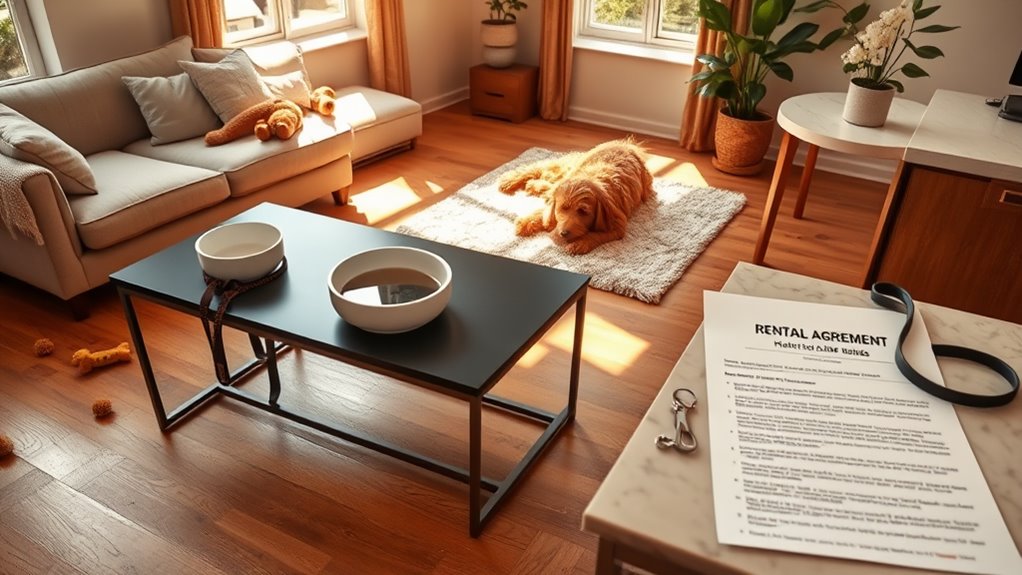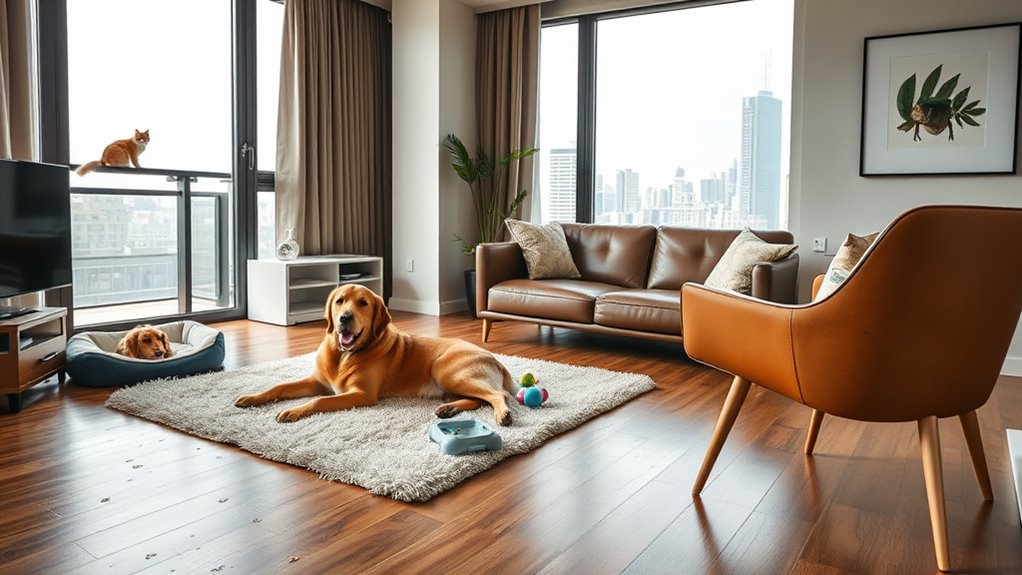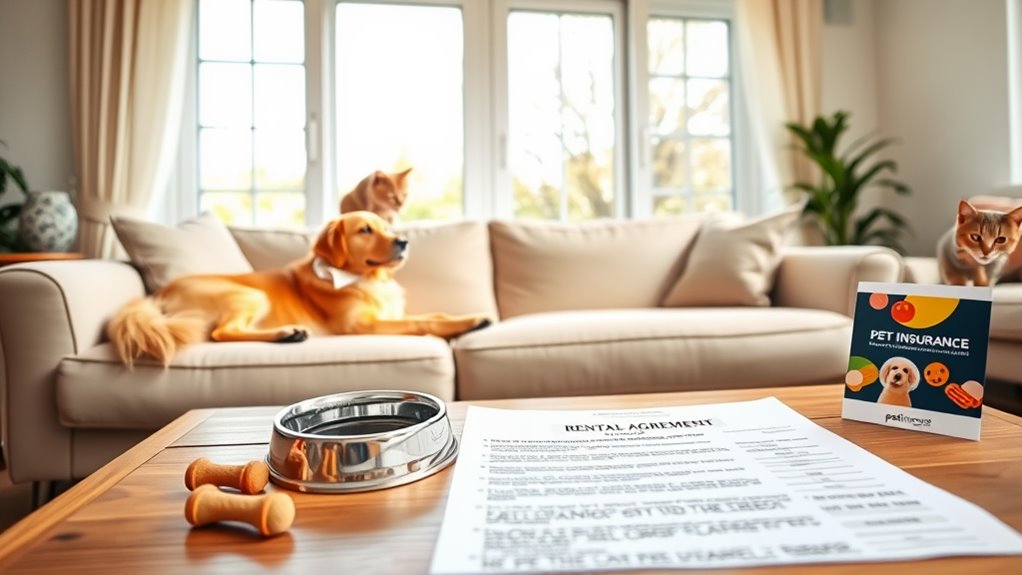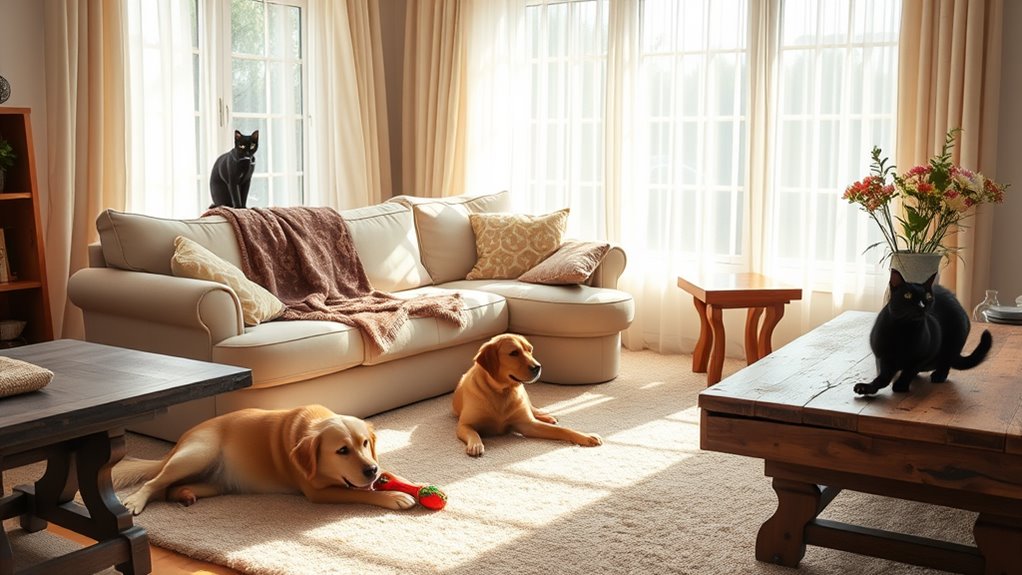Allowing pets in your rental can expand your tenant pool and reduce vacancies, as nearly half of renters own pets. You can charge higher rents and attract responsible, long-term tenants. However, you’ll need clear policies to address potential damage, noise, and odors. Thorough screening, pet deposits, and regular inspections help mitigate risks. Balancing these factors can make pet-friendly rentals profitable. Discover how to maximize benefits while minimizing challenges with the right approach.
Key Takeaways
- Pet-friendly rentals expand tenant pools and reduce vacancies by attracting nearly half of renters.
- Allowing pets can increase rental income through higher rents and pet fees or deposits.
- Pets may cause damage or odors, requiring careful screening and clear lease policies to mitigate risks.
- Insurance premiums may rise, but requiring pet liability coverage can protect against potential claims.
- Low-maintenance pets like fish or reptiles minimize noise, allergies, and property damage concerns.
Pros of Allowing Pets in Rental Properties
Allowing pets in rental properties can considerably expand your tenant pool, as nearly half of all renters have at least one pet. By welcoming pets, you tap into a larger market, reducing vacancies and guaranteeing a steady stream of applicants. Responsible pet owners often prioritize long-term rentals, lowering tenant turnover and minimizing the costs associated with frequent move-outs. Additionally, pet-friendly rentals can command higher rents, as pet owners are willing to pay a premium for accommodations that cater to their furry companions. While concerns about property damage exist, responsible pet owners typically maintain their spaces well, often investing time and effort into keeping their surroundings clean and safe. Accommodating assistance animals also guarantees compliance with fair housing laws, fostering inclusivity. Embracing pets can transform your rental property into a sought-after option, balancing tenant satisfaction with financial benefits. With national vacancy rates remaining low at around 4%, pet-friendly rentals can further secure a competitive edge in the market.
Cons of Allowing Pets in Rental Properties
While welcoming pets can broaden your tenant pool, it also introduces potential challenges for your rental property. Pets can cause significant damage, such as scratched floors, chewed furniture, or stained carpets, leading to costly repairs. Pet accidents can leave lingering odors, requiring deep cleaning before the next tenant moves in. Additionally, noise from barking or other disturbances may disrupt neighbors, complicating property management.
To minimize risks, consider these key points:
- Damage control: Pets may inadvertently harm your property, requiring repairs or replacements.
- Odor issues: Persistent smells from pet accidents can deter future tenants.
- Noise complaints: Barking or other noises may strain tenant relationships.
- Enhanced screening: Thorough tenant screening guarantees responsible pet ownership and reduces risks.
Careful planning and clear policies can help mitigate these cons while maintaining a pet-friendly rental environment.
Financial Considerations for Pet-Friendly Rentals

You can charge higher rents for pet-friendly properties since they attract a larger pool of tenants. Be prepared for increased maintenance costs due to wear and tear from pets. Additionally, check if your insurance premiums will rise and guarantee coverage aligns with any pet-related liabilities.
Increased Rental Income
Pet-friendly rentals offer landlords a clear financial advantage, enabling them to charge higher rents and attract long-term tenants. Pet owners are often willing to pay a premium for a pet-friendly property, providing you with increased rental income. Here’s how allowing pets can benefit your bottom line:
- Higher Rent Potential: You can charge pet fees or deposits, adding to your monthly earnings.
- Lower Vacancy Rates: Pet owners struggle to find suitable housing, so they’re more likely to stay longer.
- Improved Lease Renewal Rates: Pet-friendly homes enjoy lease renewal rates 1.6 times higher.
- Expanded Tenant Pool: With 67% of U.S. households owning pets, you’ll attract a larger market.
- Regional Amenities: Including quality parks and nearby pet services can further enhance your property’s appeal and rental value.
Higher Maintenance Costs
Many landlords face increased maintenance costs when allowing pets in rental properties due to potential wear and tear on flooring, furnishings, and interiors. Pet damage can lead to costly repairs, such as fixing scratched walls, replacing carpets, or refinishing hardwood floors. You’ll also need to budget for frequent deep cleaning to address odors and allergens, which adds to your operational expenses. To mitigate risks, you can specify expectations in the rental agreement, such as requiring pet owners to cover certain repairs. Additionally, invest in durable materials like stain-resistant carpets or scratch-resistant flooring to reduce long-term costs. While these upfront expenses may seem high, they often pay off by minimizing pet damage. Inform insurance companies about your pet policy, as this may influence coverage terms and guarantee you’re prepared for potential claims. Analyzing local market demand can also help determine if the increased rental income from pet-friendly units offsets higher maintenance expenses.
Insurance Premium Impact
Insurance premiums for rental properties can rise when pets are allowed, as insurers often account for the increased risk of pet-related incidents. To navigate this effectively, consider these steps to manage your financial exposure while accommodating pet owners:
- Review Your Policy: Confirm with your insurance provider how pets impact your premiums and if restrictions apply to certain breeds.
- Disclose Pet Ownership: Ascertain tenants disclose pets to avoid denied claims during incidents.
- Require Renters Insurance: Mandate tenants to secure renters insurance with pet liability coverage to protect against damages.
- Weigh Risks: Balance the benefits of attracting pet owners with the potential increase in insurance costs.
- Streamline Processes: Utilize flexible terms to accommodate pet owners while maintaining financial stability and reducing administrative burdens.
Tenant Management Strategies With Pets
When managing tenants with pets, you’ll want to implement strategies that balance their needs with property protection. Start by conducting thorough tenant screenings, including a pet interview, to assess the pet’s behavior and guarantee responsible ownership. Incorporate a detailed pet clause in the lease agreement, clearly outlining tenant responsibilities for pet care, damages, and cleaning to minimize disputes. Regularly schedule property inspections to monitor the rental’s condition and address any pet-related issues early. Maintain open communication with tenants about pet policies to foster cooperation and reduce misunderstandings. Collect a pet deposit to cover potential damages, ensuring tenants understand the financial implications of pet ownership while providing a safety net for property upkeep. These tenant management strategies help maintain a harmonious rental environment while safeguarding your property from unnecessary risks.
Types of Pets and Their Impact on Rentals

Fish are a low-risk option in rentals, as they rarely cause noise or damage unless a tank breaks. Reptiles and amphibians provide a quiet presence, though you’ll need to guarantee their habitats are well-maintained to avoid odors. Small animals like hamsters and rabbits are low-maintenance and can be contained in cages to prevent escapes or damage.
Fish: Minimal Risk
Since they’re low-maintenance and unlikely to cause damage, fish are often a preferred choice for landlords allowing pets in rental properties. Unlike dogs or cats, fish don’t scratch floors, chew furniture, or create noise disturbances, making them ideal for tenants and property owners alike. However, potential concerns like aquarium leaks can be minimized with proper care. Here’s why fish are a practical option:
- Low maintenance: Feed them regularly and clean their tank—simple tasks for tenants.
- No noise complaints: Fish are silent, ensuring peace for neighbors.
- Allergy-friendly: They don’t shed fur or dander, making them suitable for sensitive renters.
- Minimal property damage: With sturdy tanks and proper placement, risks like water damage are rare.
Reptiles: Quiet Presence
Reptiles, including snakes, lizards, and turtles, offer a quiet and low-maintenance alternative for tenants in rental properties. Their minimal noise makes them ideal for multi-unit buildings, where sound disturbances can be an issue. When properly cared for, reptiles create little to no odor, ensuring a clean environment for both you and your tenants. However, some landlords may hesitate to allow certain reptiles, particularly snakes, due to safety concerns. It’s crucial to evaluate the pet owner’s responsibility and the specific type of reptile before making a decision. Reptile ownership requires a commitment to habitat maintenance, which can demonstrate a tenant’s dedication to care. Consider the following factors when allowing reptiles in your rental:
| Factor | Consideration |
|---|---|
| Noise Level | Virtually silent |
| Odor | Minimal if maintained properly |
| Maintenance | Regular habitat cleaning |
| Landlord Concerns | Case-by-case evaluation needed |
| Tenant Responsibility | Demonstrates care commitment |
Small Animals: Low Maintenance
Although small animals like hamsters, gerbils, and rabbits might not be the first pets that come to mind, they’re often an excellent choice for tenants in rental properties due to their low-maintenance nature. These pets require minimal care, produce little noise, and, if properly caged, don’t create unpleasant odors, making them ideal for shared living spaces. For landlords, small animals can be a practical option to attract potential tenants without significant property risks. To guarantee clarity and accountability, include specific guidelines in lease agreements. Understanding tenant demographics can help landlords tailor policies to meet the needs of pet-owning renters.
When considering low-maintenance pets for rental properties:
- Space Efficiency: Small animals don’t need much room, fitting easily in compact living spaces.
- Minimal Damage: Proper containment reduces the risk of property damage.
- Neighbor-Friendly: Quiet and unobtrusive, they’re less likely to disturb others.
- Ease of Care: Simple routines make them manageable for busy tenants.
Mitigating Risks Through Screening and Policies
To effectively mitigate risks when allowing pets in rentals, implementing thorough tenant screenings and clear policies is vital. Start with in-depth tenant screenings that include pet interviews and behavioral assessments to identify responsible pet owners. Include detailed pet clauses in your lease agreements, specifying responsibilities for maintenance, care, and pet behavior. Require tenants to provide documentation of vaccinations and licensing to guarantee compliance with local regulations. Schedule regular property inspections to monitor for damage or odor issues and address concerns promptly. A pet deposit or fee can provide financial protection against potential damages while encouraging tenants to care for the property responsibly.
| Action | Benefit | Impact |
|---|---|---|
| Conduct tenant screenings | Identify responsible pet owners | Reduce risks of property damage |
| Include clear pet clauses | Set expectations for pet care | Minimize disputes |
| Require a pet deposit | Protect against financial losses | Encourage accountability |
Insurance and Legal Considerations for Pet-Friendly Rentals

When allowing pets in rentals, you’ll need to navigate insurance and legal considerations to safeguard your property and minimize liabilities. Start by reviewing your landlord insurance policy to confirm coverage for pet-related incidents, such as bites or property damage, and check for breed restrictions. Require tenants to provide proof of renters insurance with pet liability coverage to further protect yourself. Additionally, establish a reasonable pet deposit to cover potential damages while complying with local laws. Here’s a breakdown of key steps:
- Confirm insurance coverage for pet-related liabilities and verify tenant policies.
- Implement a pet deposit to address potential damages.
- Comply with the Fair Housing Act by accommodating service animals and emotional support animals.
- Check local HOA rules and legal restrictions on specific breeds or pets.
- Consider seller financing options to ease financial burdens when purchasing pet-friendly rental properties.
Enhancing Property Appeal for Pet Owners
After addressing insurance and legal considerations, it’s important to focus on making your rental property more attractive to pet owners. Enhance property appeal by installing durable flooring like linoleum or vinyl, which resist damage and are easier to clean. Designate a pet potty area in the yard to encourage responsible pet ownership and maintain cleanliness. Create a fenced-in area to provide a safe outdoor space for pets to play, which can be a major selling point for pet owners. Consider minor modifications, such as built-in pet beds or shelving for pet supplies, to add convenience. Additionally, offering amenities like pet washing stations or easy access to nearby parks can further elevate your property’s attractiveness. Highlighting local culture and vibe through nearby attractions can also increase your property’s appeal and create a compelling market narrative. These practical upgrades not only appeal to pet owners but also help guarantee your rental remains well-maintained and competitive in the market.
Conclusion
Picture your rental property buzzing with life—cheerful barks echoing, a cat lounging in a sunlit window, and pet owners grateful for their haven. By allowing pets, you open the door to loyal tenants and a thriving community. Protect your investment with clear policies, thorough screening, and tailored insurance. Balance risks with rewards, and watch your property transform into a sought-after, pet-friendly retreat. Imagine the possibilities, and embrace the sense—and scents—of progress.




